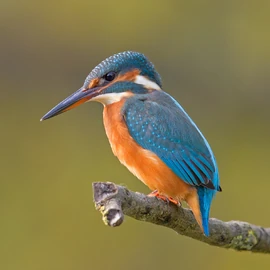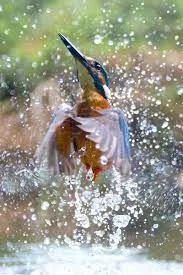How do the Common Kingfishers come from
The Common Kingfisher is originally from Europe, Asia, and parts of North Africa. It lives near rivers, lakes, and streams, where it finds plenty of fish to eat.
This bird has adapted well to different freshwater habitats, making it a familiar sight in many regions. Its ability to thrive in various environments has helped it spread widely across its natural range.
Scientific Name and Classification of Common Kingfishers
- Scientific Name: Alcedo atthis
- Family: Alcedinidae (Kingfisher family)
- Order: Coraciiformes (includes kingfishers, bee-eaters, and rollers)
This bird belongs to a group known for its fishing skills and unique appearance.
Physical Appearance of Common Kingfishers
The Common Kingfisher is a small, colorful bird with some striking features:
- Size: It measures about 16-17 cm (6-7 inches) in length, making it quite small.
- Weight: It weighs between 34-46 grams, which is very light.
- Color: Its back shines with bright blue feathers, while its belly is a warm orange color. It also has a white patch on its throat.
- Beak: The beak is long, sharp, and pointed, perfect for catching fish.
- Eyes: Its large, dark eyes provide sharp vision, helping it spot prey both above and below the water’s surface.
These features make the Common Kingfisher easy to recognize and well-suited for its fishing lifestyle.
Habitat of the Common Kingfishers
The Common Kingfisher lives near freshwater places where it can catch fish. Its favorite homes include:
- Rivers– Moving water with plenty of fish.
- Lakes– Still water areas that are good for fishing.
- Streams– Shallow waters where they can catch fish easily.
- Ponds– Calm water spots where they can rest and hunt.
They need clear water to see and catch fish easily. They also need good resting spots like tree branches or rocks near the water for hunting.
Caring for Common Kingfishers (For Bird Lovers)
Taking care of a Common Kingfisher at home needs proper space and regular attention:
Home Setup:
- Make a large cage with clean water pools for fishing practice.
- Add branches, logs, or rocks for resting and hunting practice.
Food:
- Feed them live fish such as minnows and small water insects.
- Give them a healthy and balanced diet to keep them strong.
Health Check:
- Watch for signs of sickness like less activity or not eating well.
- Take them to a bird doctor (vet) for regular checkups and care.
Good care helps Kingfishers stay active, healthy, and happy.
Grooming and Cleaning of Common Kingfishers
Common Kingfishers clean themselves in the wild, but bird owners can help keep them neat and healthy because it is important for their grooming and cleaning:
Clean Water Supply:
- Always provide fresh and clean water for bathing.
- Change the water often to keep it from getting dirty.
Perch Cleaning:
- Keep branches, logs, and rocks clean and free from dirt or droppings.
- Wipe them or replace them if they get too messy.
Cage Cleaning:
- Clean the bird’s cage or living space often to prevent sickness.
- Remove leftover food or fish parts to avoid bad smells and germs.
Fun Activities for Common Kingfishers
Keeping Kingfishers busy helps them stay happy, active, and healthy. Here are some fun activities ideas:
Fish-Hunting Practice:
- Put small live fish in shallow water for them to catch.
- This keeps their hunting skills sharp and makes their day fun.
Floating Platforms:
- Place small floating items like logs or platforms in the water.
- These give the bird a place to rest and watch what’s around.
Perch Moving:
- Change where the perches are placed from time to time.
- This makes the bird’s home more exciting and fun to explore.
These activities keep Kingfishers active, healthy, and entertained.
Interesting Facts About the Common Kingfishers
1. Amazing Divers:
They can dive quickly into the water to catch fish, using a special eyelid to see underwater.
2. Skilled Hunters:
Their sharp beak and strong neck muscles help them catch fish easily.
3. Special Nesting Habits:
They dig tunnels into riverbanks to make safe nests for their eggs.
4. Sharp Vision:
Their eyes are perfect for spotting fish and other prey, both in the air and underwater.
5. Territorial Birds:
They strongly protect their fishing spots and will chase away other birds.
6. Fast Flyers:
Despite being small, they are quick and can fly easily through the air.
7. Eco-Helpers:
When you see a Common Kingfisher, it’s a good sign that the water around it is clean and healthy.
8. Cultural Symbol:
In many cultures, the Common Kingfisher is a symbol of peace, prosperity, and love.
9. Long Breeding Season:
Their breeding season can last from March to August, depending on where they live.
10. Survivors:
Even with changes in the environment, the Common Kingfisher is still found in many places because it can adapt to different conditions.
Final Words
The Common Kingfisher is a truly amazing bird, loved for its bright colors, speed, and special way of living. Whether you’re a bird fan, a nature lover, or just curious, learning about this beautiful bird is exciting. Its colorful feathers and impressive hunting skills make it stand out in nature. The Kingfisher lives near rivers, lakes, and ponds, showing us how healthy and beautiful the natural world can be. Its ability to live in different places and adjust to changes makes it a symbol of life, freshness, and balance in nature.
Most Commonly Asked Questions About Common Kingfishers
Where do common kingfishers live?
➤ Common kingfishers live in Europe, Asia, and North Africa.
➤ They are found near clean rivers, lakes, ponds, and streams with slow-moving water.
➤ They like places with lots of fish and safe spots to nest, like riverbanks.
Are common kingfishers endangered?
➤ No, common kingfishers are not endangered.
➤ But their numbers can drop in some areas due to water pollution or habitat loss.
How common are kingfishers?
➤ They are fairly common in places where the water is clean and there is enough food.
➤ In cities or polluted areas, they are less common.
Is seeing a kingfisher lucky?
➤ In many cultures, yes, seeing a kingfisher is a sign of good luck, peace, or new beginnings.
➤ Some people believe it brings positive energy and hope.
